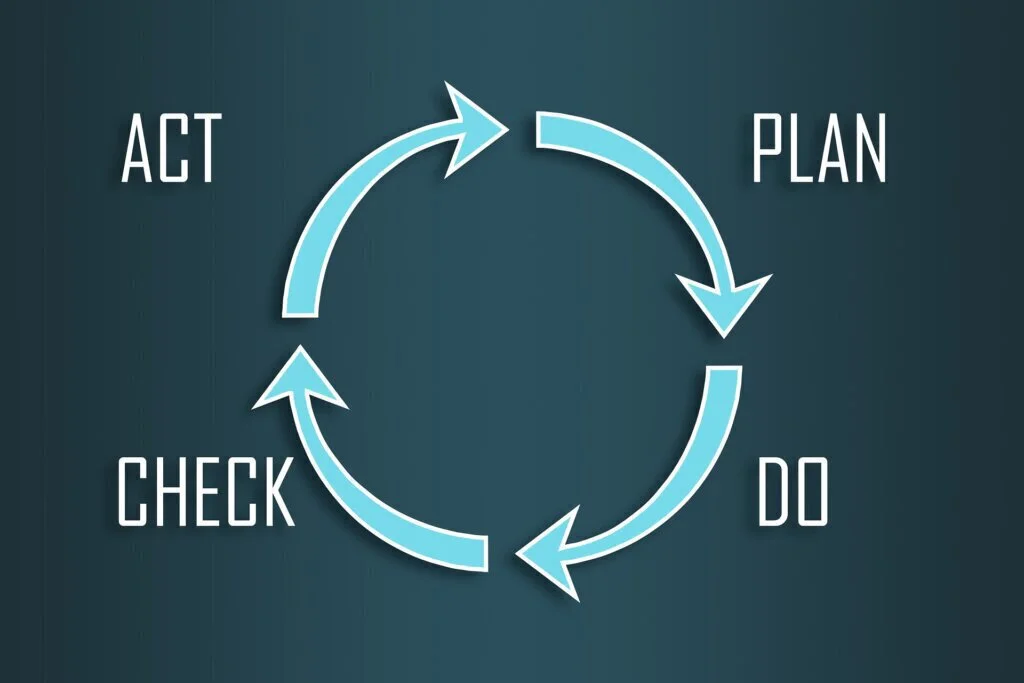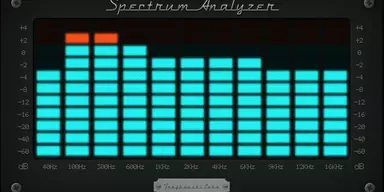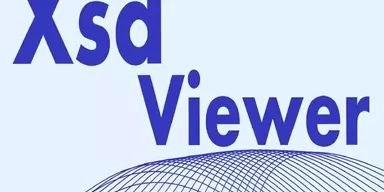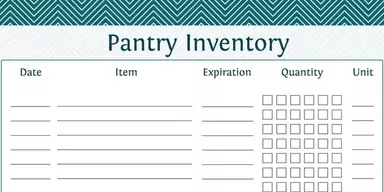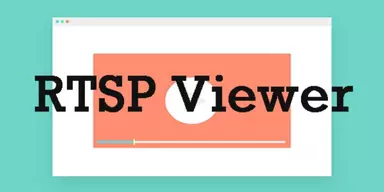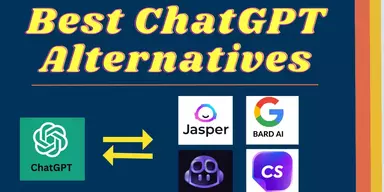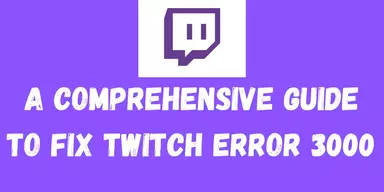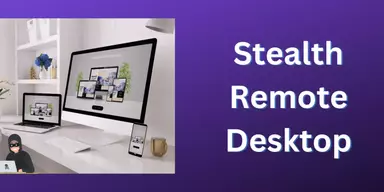Agile project management is a fast approach to providing a project using a complete life cycle. An agile life cycle consists of many incremental steps or iterations for completing the project. Such types of iterative approaches are used in the development of software projects. The only benefit of the iteration method is that you can go along to get your target. The sole aim of an agile approach to providing benefits throughout the working process of a project.
Agile project management includes flexibility, collaboration, central value, and behavior of trust. Agile management gives maximum progress within a given budget and time. It breaks a project into smaller tasks and subtasks and assigns them to related team members. It also promotes collaborating, working to increase performance. It learns, reflects, and adjust things to satisfy the customer and provide positive outcomes.
The agile methodology includes planning and execution, enabling a company to generate a working mindset. Agile management is similar to project management, but it is especially useful for software developers. Otherwise, it also uses the same tools and features to manage projects and other tasks related to projects.
What is Agile Project Management Software?
For creating and executing complex and large software related projects in time effective manner, organizations work with specific software. Such management software is known as Project management software. This application generates deadlines for projects and provides a complete image of the project. The use of agile applications extends in businesses like construction, advertising/marketing, product development, education, finance, architecture, manufacturing, and event planning.
An agile management software uses three primary agile methodologies like DSDM, extreme programming, or scrum agile development methods. Some agile project management tools are also providing mobile apps to facilitates their team members. IT and software companies work with agile management tools to deliver projects and products effectively and quickly.
Best Agile Project Management Software
Here is the list of Best Agile Project Management Software that is providing numerous tools for reporting, agile management, monitoring, and tracking.
1. Nifty
Nifty is an agile work management application created for project enterprises to accelerate project cycles, align project teams, and make project reports automatically. This program provides more control over project details with capabilities like file sharing, collaboration support, and time tracking. With Nifty PM, project managers can avoid late deliveries and missed deadlines, and speed up project cycles.
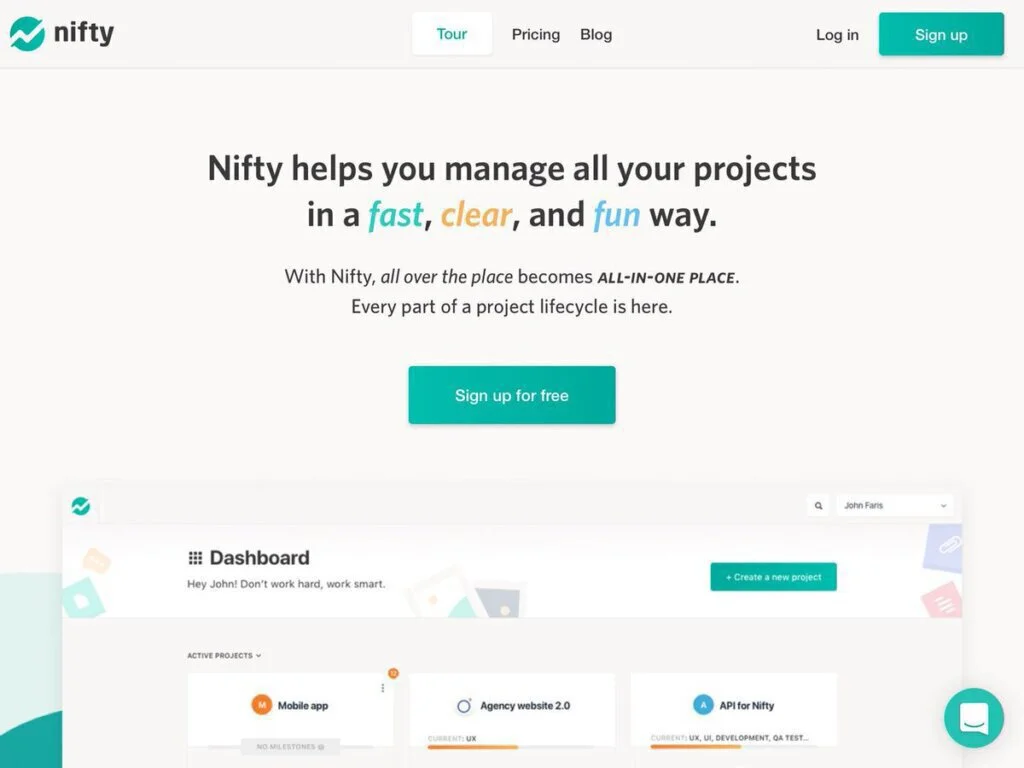
This workflow collaboration hub connects all team members and allows you to set project goals and generate timelines for deliverables. The file-sharing option facilitates every on to give suggestions and share files on a single hub. The program saves every project related record in a secure location, and you can access data from Dropbox, Google Drive, and computers. Milestone View of this system provides complete details related to project sprints, initiatives, and phases.
Align your team and clarify project objectives using a Swimlane View. You can allow project managers to monitor the time of employees spent on tasks and get insights on project time. They can manage employees’ workloads by tracking their working hours and ensure that workload will be complete on time. A manager can create documents with any team member in the form of Nifty Doc, spreadsheets, or Google Docs and sync these documents with Google Drive.
Features
- Progress reporting
- Time tracking
- Conversational files
- Milestone dependencies
- Custom labels
- Time logs view
- Project overview
- Message threads
- Direct messaging
Pros
- Custom fields
- Task assignment
- Real-time collaboration
- File sharing
Cons
- Sprint velocity need improvements
Pricing
- Trial: Free
- Free: $0
- Standard: $89
- Premium: $124
- Enterprise: Contact vendor
Visit: Nifty
2. SpiraTeam
SpiraTeam is a cloud-based lifecycle management platform for managing tests, releases, issues, tasks, and requirements in a single environment. The application offers integrated dashboards of different project status and health information, allowing you to track everything related to projects like tracking of project plans and bags. The program offer support for agile methodologies such as Scrum, XP, AUP, Kanban, and DSDM for managing all details in one platform.
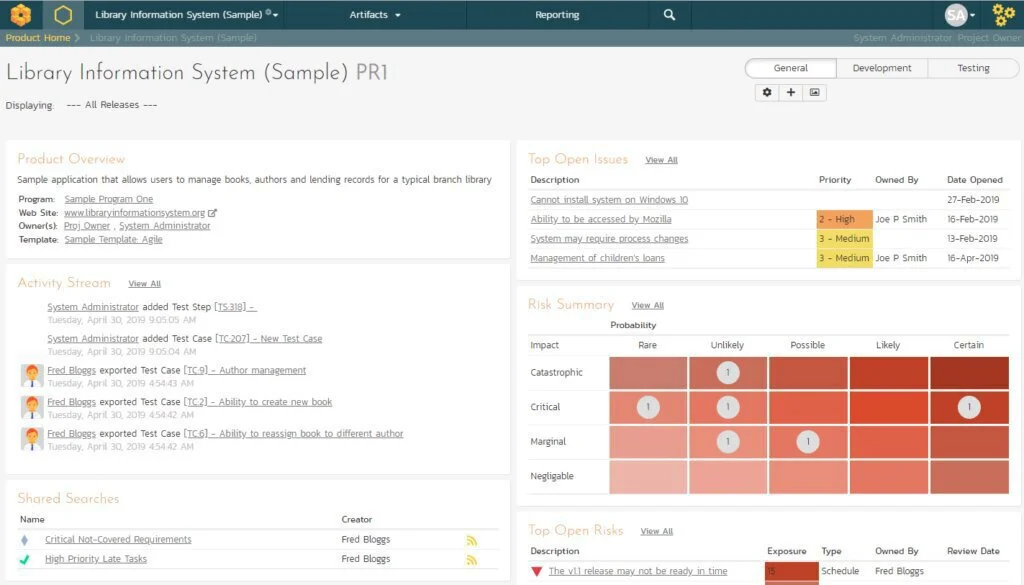
You can control the company’s user stories and requirements in the requirements matrix. The program will disappear the shackles of outdated methods and will boost up the testing team of your company. This platform allows us to view the list of versions or releases and break each release into small parts for easy management. Besides, you can balance task resourcing allocations and schedule the projects with your team members. Team members have the facility to update the progress of their work.
SpiraTeam provides full support for tablets and smartphones by giving iOS and Android apps. It includes an online document management system that allows persons to insert documents in a safe location and offers support for folder organization, built-in version control, meta-tagging, and documentation taxonomies. You can chat with team members using instant messaging capability.
Features
- Create and execute test-cases
- Capture requirements
- Allocate requirements
- Schedule requirements
- Track issues, risks, and enhancements
Pros
- Document management system
- Web-based user interface
- Audit history
- Instant messaging tool
Cons
- Missing specific functions
Pricing
- Trial: Free
- Single: $9.99/month
- 3-User: $79.99/month
- 5-User: $119.99/month
- 10-User: $199.99/month
- 20-User: $279.99/month
- 50-User: $399.99/month
Visit: SpiraTeam
3. Wrike
Wrike is a web-based agile project management platform created to boost the work of distributed groups. The program can simplify and prioritize the task request by providing meetings, chats, and emails to teams. The program helps to remove miscommunication, rework, and costly error and provides complete progress of a project. This system includes easy to customize requests like Change/Issue Requests, New Project Requests, Creative Briefs, and Proposals.
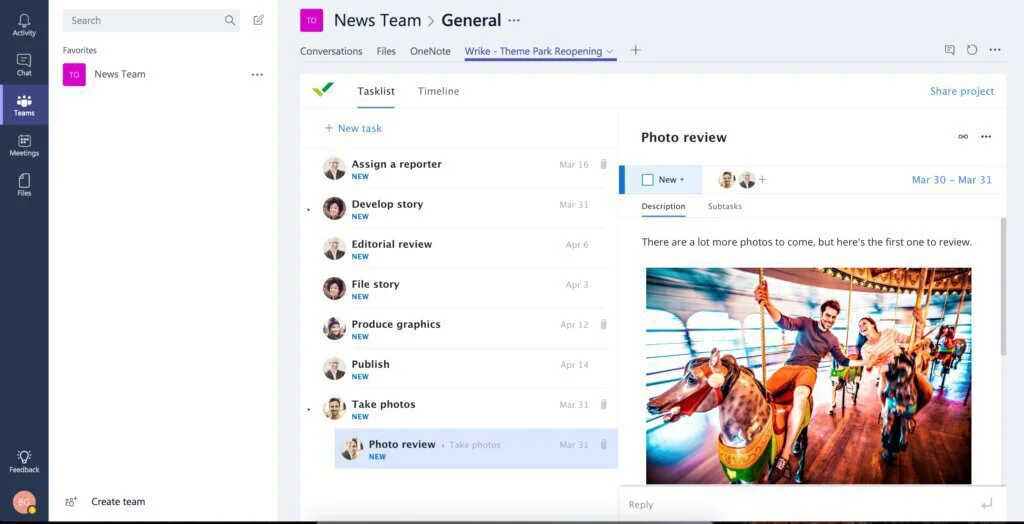
Enterprise-grade audit reports assist admin in monitoring activities of individuals and groups and stopping malicious activities. He can create an audit report check threats and secure information and other tasks. A complete set of interesting features are there to simplify administrative burden. Issue a single request to create a journey and manage projects accurately and rapidly.
Email integration helps admin to generate and edit files from the email account and work with Google Drive to communicate with other team members by attaching and sending files instantly. Wrike offers integration with third-party solutions to increase its working power. Create Global Reports to get tasks from different folders, and Performance Chart provides a visual look of projects with their deadlines. Get details of your team performance and view tasks metrics such as due date and status.
Features
- Document collaboration
- Task management
- Interactive timeline
- Real-time newsfeed
- Discussions in tasks
- Mobile apps
- Customized reports
Pros
- Google Docs integrations
- Email integrations
- Recurring tasks
- Time tracking
Cons
- Daunting setup
- Clunky interface
Pricing
- Trial: Free
- Free: $0
- Professional: $9.80/user/month
- Business: $24.80/user/month
- Marketers: $34.60/user/month
- Enterprise: By quote
Visit: Wrike
4. Atlassian Jira
Atlassian Jira is a leading agile project management solution that assists professionals to delegate and prioritize their tasks. The program offers support for Kanban, Scrumban, and Scrum methodologies. It has a major focus on agile project management and provides the facility to get evidence at numerous stages of the process. It provides support for all types of estimation methods like hours and story points.
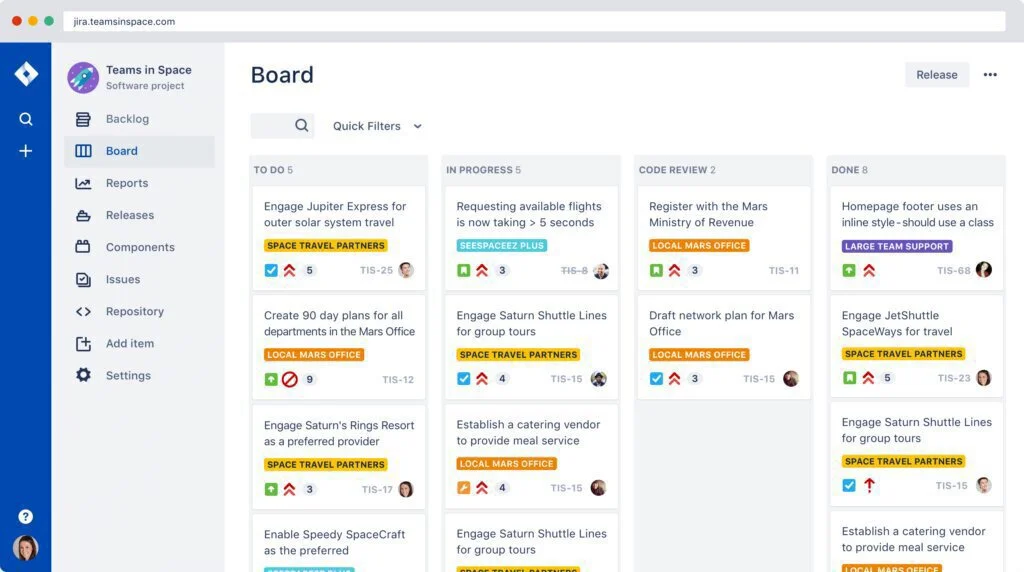
Organize the order of the articles in the backlog like issues, stories, and bugs using drag and drop functionality. It is a feature-rich and highly customizable system that work with Scrum, Kanban, and Scrumban approach to help every project user. The application offers default workflows, fields, issue types, and states, and you can alter them according to your requirements. Issue schemes and generate custom workflows in certain cases.
Get a 360-degree view of project progress and send instant notifications to team members on their related topics. They can share ideas, communicate, and insert important files. A Jira Query Language is there to track bugs and issues for project assistance. Connect with GitHub and BitBucket to generate a new workflow. An API architecture of Jira allows you to create integrations of your choice.
Features
- Unlimited custom fields
- Customizable workflows
- Defect and bugs management
- Advanced reporting
- Filtering and search
- Customizable dashboards
- Advanced security
Pros
- Mobile interface
- OnPremise deployment
- API architecture
- Import data
Cons
- API has drawbacks
Pricing
- Trial: Free
- Cloud-Free: $0
- Cloud-Standard: $7/user/month
- Cloud-Premium: $14/user/month
- Self-managed Server: $10
- Self-managed Data Center: $20,400 per year
Visit: Atlassian Jira
5. Pivotal Tracker
Pivotal Tracker is a story-based and user-friendly management platform that allow development team members to collaborate and generate real-time solutions for different feedback. Agile methods are behind this tool for managing commercial software development projects. Using this application, team members and developers can access and view real-time updates of the project and determine the further process.
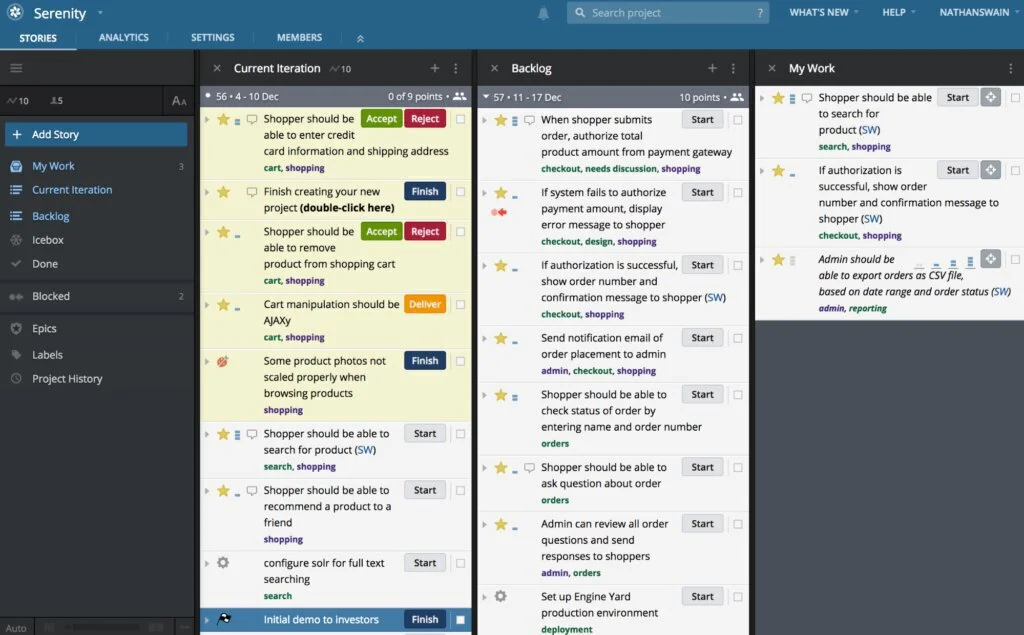
They can access and share all information and details related to the project. So developers can concentrate on other essential works rather than generating project reports. This platform assists software companies in developing software instantly by using collaboration tasks. Developers can get full control over the project through complete visibility. Effective lines of communication are there for team members and employees to share their ideas, documents, and concerns generally or privately.
Streamline your workflow by using adopting and implementing agile tasks. It offers multiple third party options to increase the productivity of the tool. API architecture of Pivotal Tracker helps you to create customized integrations. It offers multi-project workspaces and analytics and reports related to project details. It provides project history, labels, searching tools, story points, and story blockers.
Features
- Story blockers
- Story points
- Automatic planning
- Multi-project workspaces
- Analytics and reports
- Notifications
Pros
- Labels
- Feedback
- Task management
- Integrations
- Project history
- File sharing
Cons
- No estimation of tasks
Pricing
- Trial: Free
- 3 collaborators: $0
- 5 collaborators: $15
- 10 collaborators: $35
- 15 collaborators: $75
- 25 collaborators: 150
- 50 collaborators: $300
Visit: Pivotal Tracker
6. Zoho Sprints
Zoho Sprints is a web-based agile project management platform created assisting agile teams in building projects, monitoring progress, and getting the product in time. It uses a scrum board to get transparency and visibility of team members’ development. The application provides all updates in the team feeds. Customize the project status according to certain stages and needs. For easy identification, label a project as “in progress,” “to do,” and “completed.”
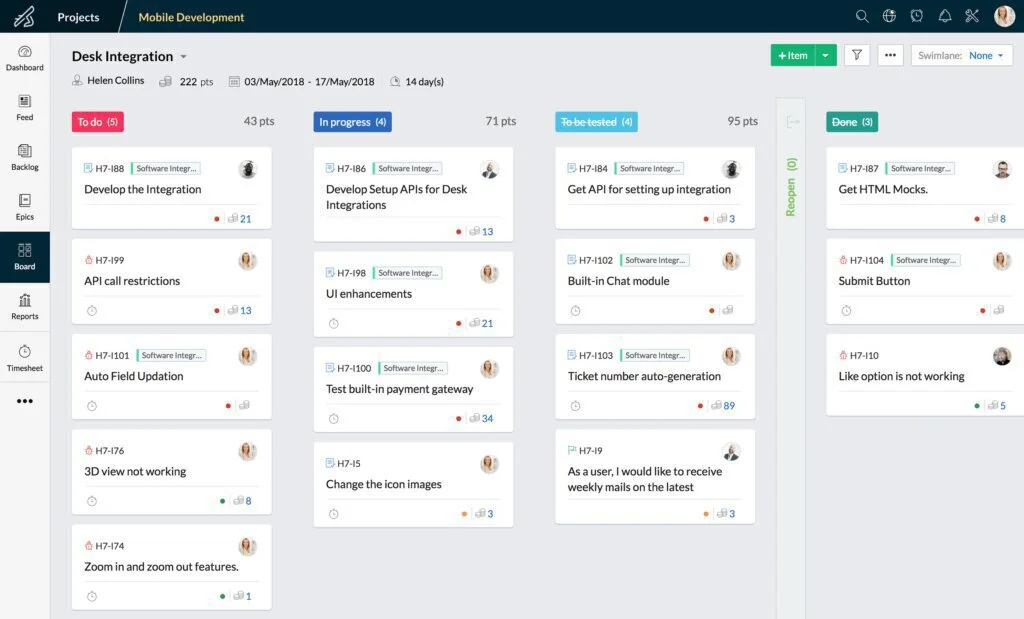
Work with drag and drop functionality to close bugs, reopen tasks, and transfer stories. A Sprint Activity graph is there to view alters made, such as added, reopened, moved, and closed items. Calculate the billable and non-billable hours of team and monitor and tabulate their time logs. Use the global timer to start, pause, or stop the time for specific articles. Product-owner and scrum master can instantly approve timesheets.
This online system facilitates you to generate backlogs and sprints for each project. Set durations, and reminders are there to notify the team about the newly released sprint. From the dashboard, get the overview of essential metrics, as well as assign and distributed workload to team members. The Cumulative Flow Diagram is there to determine bottlenecks and identify alterations in work progress. Get the delivery rate of the team from the Velocity chart and use Burnup and burndown charts to display the team’s pace.
Features
- Timesheet
- Backlog metrics
- Sprint creation
- Scrum board
- Custom status
- Personalized board
- Timesheet
- Sprint activity
- User assignments
- Priority listings
- Reminder alerts
- Global timer
Pros
- Github integration
- Custom view
- WIP limits
- Custom project templates
- Meetings module
- Velocity chart
- Activity streams
Cons
- For small organizations
Pricing
- Trial: Free
- Free Plan: $0
- Professional Plan: $12/month for 12 users
Visit: Zoho Sprints
7. Kanbanize
Kanbanize is a cloud-based agile project management system for developers to break down a project into small levels of work items. It offers Kanban boards and productivity features for handling projects. You and your team can analyze single or multiple projects and take necessary actions for improvements. It provides Work-in-progress Limits to your project timeline where you can displace the progress of specific items.
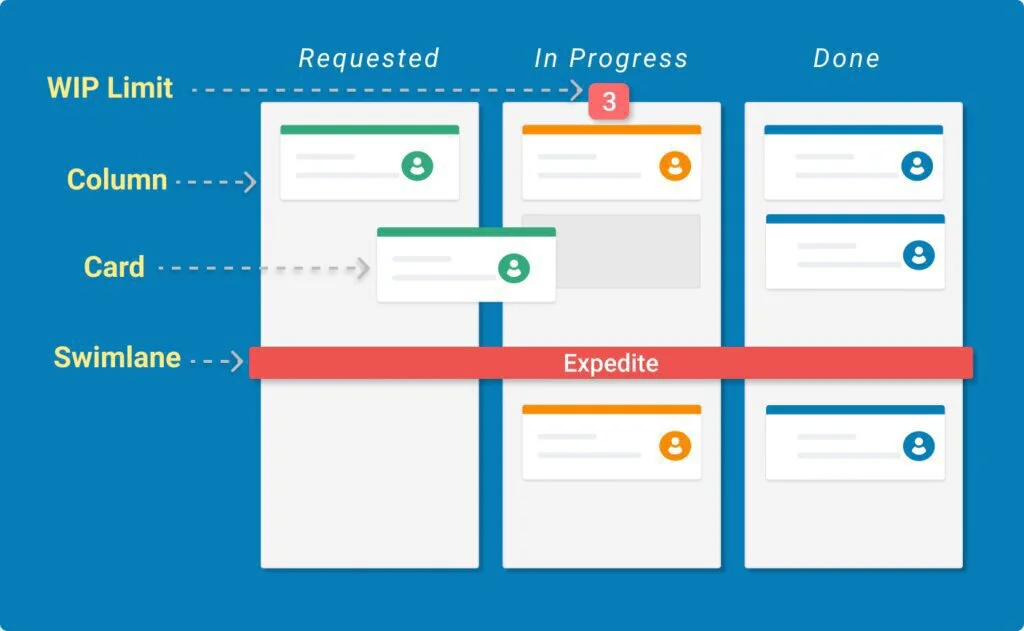
A management workspace tool allows you to generate a Kanban board and link tasks from different teams to bigger company goals. It empowers the manager to view the performance of lower levels of organizational structure. Most of the complex project includes many smaller work items for their completion. For such purpose, this system provides hierarchy and card link tool to link cards with numerous Kanban boards.
In this way, you can get visibility of each task performance and do actions required. Use email integration to transfer your Kanban boards to the flexible ticketing system. You can generate and update cards and communicate with customers in the card’s comment section. The analytics module allows you to track Lean metrics and use Carlo simulations to create a Lean metrics forecast. Analytics module offers numerous workflows charts like cumulative flow diagrams, heat map cycle, time scatter plots and aging work in progress charts.
Features
- Follow up feature
- Reminders
- Online Kanban boards
- Role-based access
- Filter searches
- Adjustable card views
- Card templates
Pros
- Card linking
- email integration
- Monte Carlo simulations
- Cumulative flow diagram
- Automated actions
- Color-coded cards
Cons
- Ugly design
Pricing
- Trial: Free
- License Seats 1–15 Users: $119 / month
- License Seats 15–20 Users: $129 / month
- License Seats 20–25 Users: $159 / month
- License Seats 25–30 Users: $199 / month
- License Seats 30–40 Users: $249 / month
- License Seats 40–50 Users: $299 / month
- License Seats 50–75 Users: $449 / month
- License Seats 75–100 Users: $529 / month
Visit: Kanbanize
8. Drutas
Drutas is a project management and agile project development system created to allow enterprises and organizations to increase their productivity. In this platform, developers and team members collaborate effectively and efficiently, give projects according to client needs and specifications, and apply smart project strategies and plans. It is an ideal system for generating workable budgets and allocating resources for better work.
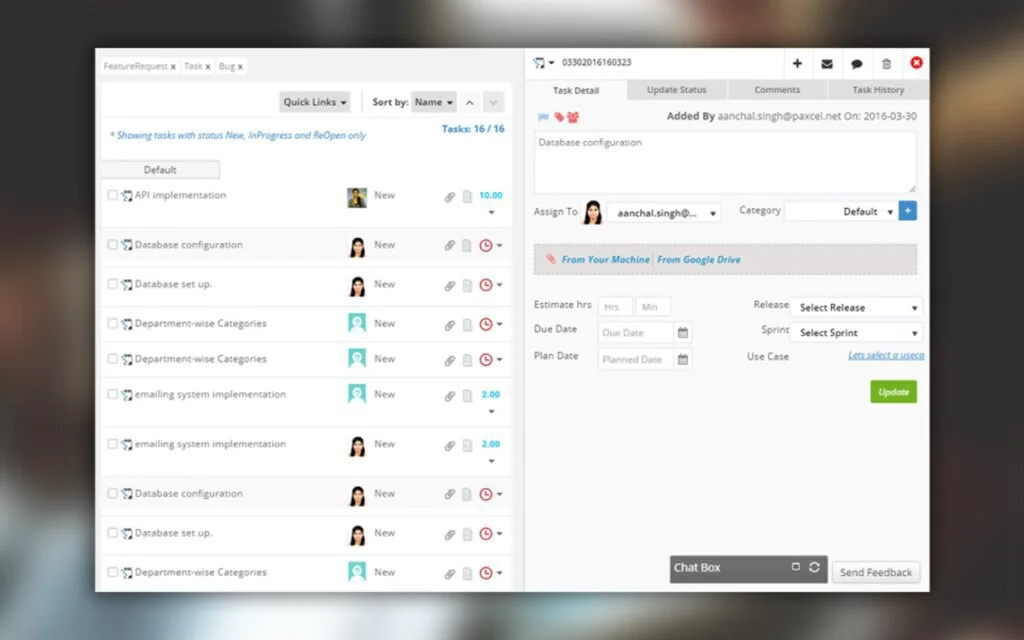
This platform brings people together to develop conceptualizing projects. Some advanced tools give a complete view of schedules, personnel, priorities, and projects. Drutas enables developers to execute required adjustments, develop projects within budget and schedule, and make data-driven decisions. You can assign tasks to team members, edit tasks, and view monthly weekly and daily schedules. Plus, notify your team about changing the schedule using smart calendar functionality.
It facilitates you to manage all processes to employees leaves, like process leave requests, deny and access them, and appreciate employees to submit their applications from desktop or mobile devices. Work with a smart time tracking tool to monitor the time and performance of your team members, plan your work, set schedule, and effectively manage your time to enhance overall productivity.
Features
- Email capture
- Multiple captures
- Role management
- Real-time chat
- Web notifications
- Discussion threads
- Reporting
Pros
- Task estimation
- Capacity planning
- Custom dashboards
- Custom reports
- Kanban boards
Cons
- No mobile apps
Pricing
- Trial: Free
- Beginner: $0
- Proficient: $99/month
- Expert: $150/month
Visit: Drutas
9. Hansoft
Hansoft is a handy agile project management application for the developer to enhance their capabilities and productivity. The program provides flexible planning tools for both long-term and short-term projects. You can modify its blazingly fast interface to boost your processes and workflow. A single backlog is there for prioritizing, refining, estimating, and other custom attributes.
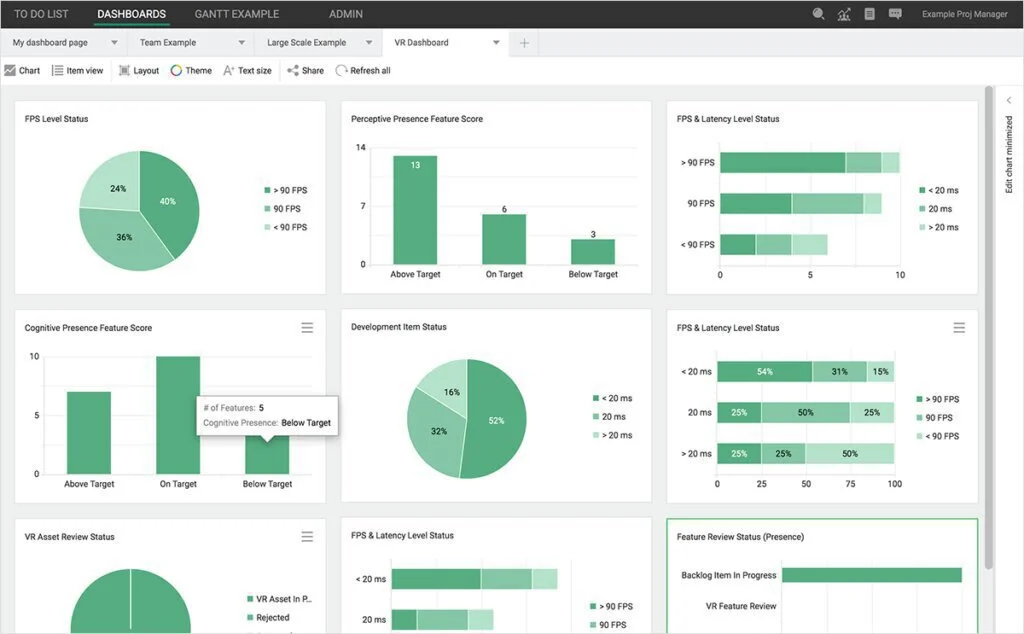
It all workers, managers, and decision-makers to view, prioritize, and track their projects and tasks. They can get real-time insights into projects based on recent, workable, and reliable information. Hansoft gives a flexible and efficient system to keep things moving smoothly. You can use or combine multiple project management methodologies like Kanban, Gantt, Scrum, SAFe, and Waterfall to manage your projects.
It brings all people of the organization to the same page for the backlog. From there, it is easy to estimate, prioritize, refine, and assign custom attributes. This platform allows the team to check the status and progress of their tasks. You can get all the details through analytics and dynamic reporting. It provides flexible release tagging, insight sharing, and program planning.
Features
- Native Windows, OSX, and Linux
- Kanban and Scrum
- Product backlog
- Release tagging
- Program planning
Pros
- Insight sharing
- Quality assurance
- Portfolio overview
Cons
- Need advance knowledge
Pricing
- Trial: Free
- Quote-based Plan: Contact the vendor
Visit: Hansoft
10. Backlog
Backlog is a fast and advanced project management solution designed for helping in software development. The application can boost coordination, collaboration, and communication between technical and non-technical team persons. This program can split projects into tasks and subtasks and assign subtasks among team members. It allows you to monitor progress status and other updates, start and end dates, categories, project milestones, and other custom fields.
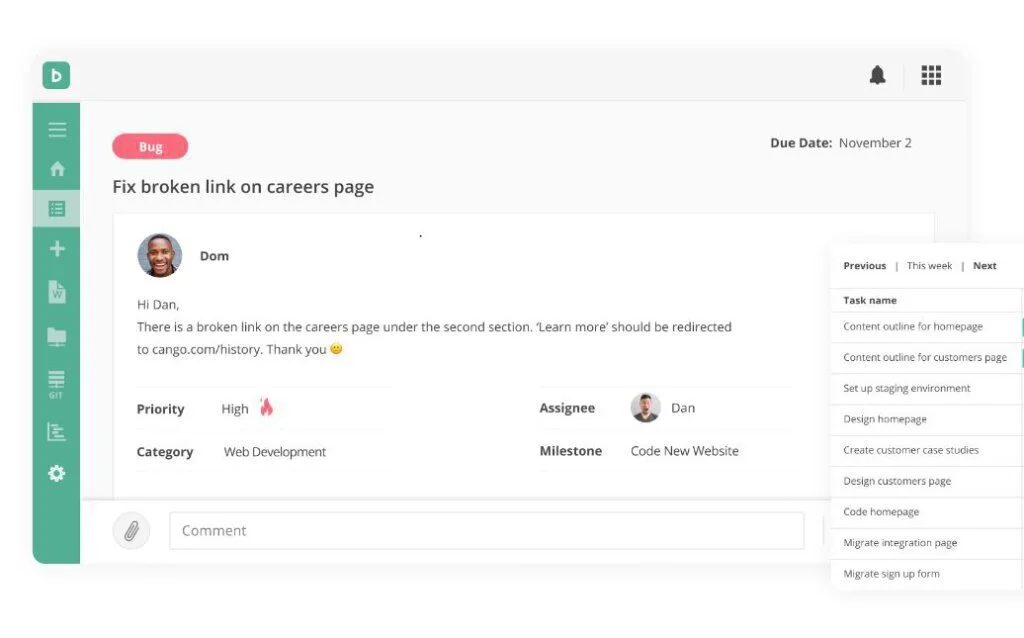
Your team member can make UI design for budget planner tools and split the task into subtasks. Track the progress of the project, set deadlines, and send notifications to team members about any updates. Use Gantt Charts to view the development of the tasks and related team members. Burndown and Gantt charts provide full details for projects like ongoing tasks, completion dates, and assigned team members.
You can generate reports from the charts, update assignments, due dates, and other project information from the charts. Team members can use their email addresses or web forms to report issues and get a ticket for their requests. Work admin can generate Wikis and use them as collaborative features for organizing project details and sharing information. Team members can edit and download these wikis. Save project documents on a single location and allow team members to access these documents.
Features
- Burndown charts
- Track project progress
- Prioritization
- Gantt charts
- Work requests
- Wikis
- Git Graph
Pros
- Team collaboration
- Version control
- Bug tracking
- Custom fields
- Private repositories
- File sharing
- Milestones
- Notifications
Cons
- No web push notifications
Pricing
- Trial: Free
- Free Plan: $0
- Starter Plan: $35/month
- Standard Plan: $100/month
- Premium Plan: $175/month
- Enterprise Plan: $1,200/year
Visit: Backlog
The Verdict
The above-given tools are offering the top features and options for workload management, tracking progress and time, as well as for analytics and creating reports. These flexible systems provide visual progress tolls for the complete structure of the project to identify obstacles. Team members can view completed parts of a project and notify the project parts that require improvements.
All of these applications include collaboration tools where top executives, team managers, and team members can communicate, share documents and thoughts, and increase the productivity of workload. Project managers can create accurate estimations using historical data and forecast future projects. Most of the applications offer safeguards to ensure high-quality products. Every team member can know about project progress at all stages.

